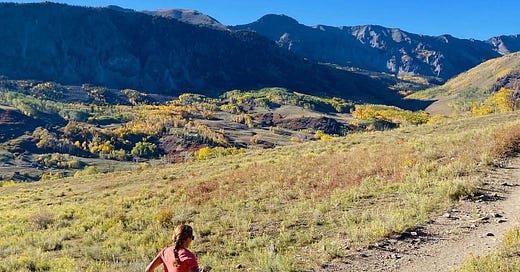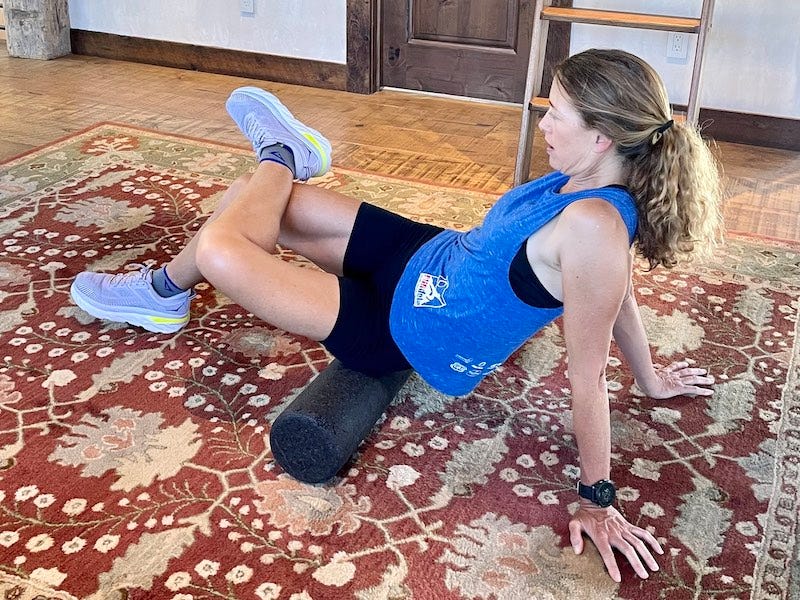When people ask what I do, I try to sound professional (coach, freelance writer, leader of a local nonprofit). I sit at my desk and do legit paid and volunteer work, from updating clients’ plans and writing articles to organizing meetings and planning fundraisers. But that’s only part of the story.
At least half of each day, I’m outside or moving around the house. I’ve never spent so much time on manual labor, and I’ve never been this content. Surely there’s a relation between the two.
I feed and exercise the horses daily, sweep the barn and check on the chickens. Hook up the harrow to the ATV and drive circles around the sand arena. Root out thistles overtaking native grasses and haul them away in a wagon.
Same goes for my husband Morgan: He tinkers with the chicken coop that he built and maintains the network of irrigation ditches that crisscross our land. He bakes sourdough weekly. With winter coming, he chops firewood and repairs the old Skid Steer. Then he goes back to conducting his business remotely.
When I’m inside, household chores distract me from professional work. Cooking, cleaning, laundry. Why don’t I ever add “homemaker” when someone asks what I do? Cleaning and maintaining this home that we built is a huge and fulfilling part of my life.
In hindsight, I wish I had spent more of my younger years—when I was raising our kids and trying to revive a mommy-tracked career as a journalist and editor—embracing hands-on homemaking and yard work rather than begrudgingly doing it as quickly as possible and delegating a lot to hired help.
Chores start out as a task viewed as a burden and obligation, done for the sake of maintenance and orderliness. Leaves need raking, dishes need washing. Our impulse may be to blow off this chore or get someone else to do it.
But, done regularly and with a mindset that welcomes rather than disdains the task at hand, chores transform from burden to pleasure, from annoying to satisfying. They become habitual, meditative, even ritualistic. They prompt healthy movement for overly sedentary lives. Filling a wheelbarrow with manure, or folding warm clothes from the dryer, gives me time to daydream along with a mood-enhancing sense of accomplishment.
Some aspects of training as a runner probably seem like not-fun chores—chronic and repetitive, but necessary.
A lot of my training could qualify as a chore. Only a fraction of what I do as a runner feels truly fun and pleasurable, such as when I reach a flow-state zone of focused effort that feels natural, playful and close to effortless. Most parts of training are methodical and at times uncomfortable.
But I’ve found these “chores,” done regularly, become ritualistic and satisfying in their own way. They’re vital for body maintenance and longevity in the sport.
These are the chores I do as an ultrarunner and advise my clients to do, too, for the sake of injury prevention, agility, healthy-weight maintenance and all-over wellness.
Mobility training: Doing mobility work—exercises to develop range of motion and proprioception—helps prevent injury and maintains mobility and agility as we age. It’s not just about stretching for flexibility; it’s about developing muscle control and balance and increasing the range of motions you can perform. I recommend dynamic (not static) stretching pre-run, and 10 to 20 minutes of yoga sequences three or four times a week. This doesn’t need to be a big time-suck involving classes at a studio. You can do it at home in shorter segments, with the help of a YouTube yogi (Kassandra and Adriene are my favorites).
Strength training: I recommend upper-body work (exercises that fatigue the whole trunk, plus basic arm strengthening) at least two, ideally three times a week, and lower-body work in the form of plyometrics and bodyweight exercises twice a week. I usually tack on 20 to 30 minutes of upper-body exercises following an easy run, and sets of lower-body exercises at the end of a hard run with higher-intensity speed work and/or hills. A strong core makes for better running, and resistance training with free weights or bodyweight maintains muscle mass and bone strength as we age. As with mobility work, this doesn’t need to be a time-suck involving trips to the gym. You can get a high-quality workout at home using your bodyweight and a few simple pieces of equipment such as dumbbells and resistance bands. (In a few weeks, I’ll share my favorite mobility and strength exercises with paid subscribers.)
Strides and hill repeats: Strides are short accelerations (20 – 60 seconds), surging toward sprint, that promote better running form and spike your heart rate and breathing. Hill repeats are basically strides uphill that build strength and cardiovascular fitness. Strides are a “chore” that truly can feel fun. I like to imagine I’m playing tag and trying to catch someone. Or visualize I’m a plane gaining speed down a runway and taking off. Hill repeats are a grind, but the flushed feeling of fatigue and a job well done afterward is undeniably satisfying, as is the benefit of running better uphill. I add strides and hill repeats to two runs a week.
Foam rolling and foot care: Sliding up and down a hard foam roller is a form of do-it-yourself myofascial release, so you get similar benefits as you’d get from massage therapy by keeping the fascia—the web of connective tissue surrounding your muscles—sliding and gliding as it should. Tightness of the fascia contributes to soreness and stiffness. But foam rolling doesn’t treat your feet, so you need to give your feet specific care, too. Use your hands to massage your arches, and/or roll a hard ball under your arch. Do “toe yoga,” scrunching and flexing your toes and trying to raise and lower your big toe independently of your other toes. These actions help prevent the dreaded condition of plantar fasciitis.
If you’ve read this while working at your desk, I hope it inspires you to stand up, stretch and take the trash out.
For further motivation, watch this wonderful short documentary, The Hard Way. Here’s the trailer.







My mom wakes up everyday and starts doing chores at 8 or even 7am. I'm still waking up drinking coffee and reading the news. I like doing dishes at 10 or 11....not 7 or 8. She carries this into overemphasizing things that don't need it. Such as 'working yourself to death' chipping thick ice off of a sidewalk so that she doesn't slip and fall and 'break a bone'....instead of simply sprinkling some sand on it and waiting for it to melt. She expects HARD WORK so much that she misses simple ways of dealing with things, relaxing and taking it easy on yourself.
You are such an inspiration! I loved reading this. I aim for have your lifestyle (this is coming from an 18 year old) Keep sharing!